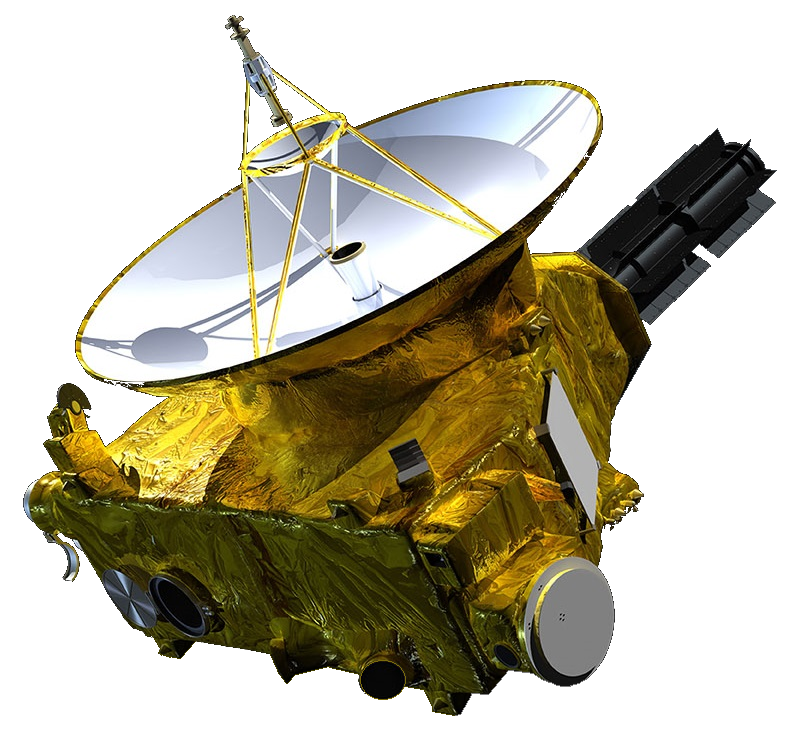New Horizons
 ''New Horizons'' is an interplanetary space probe launched as a part of NASA's New Frontiers program. Engineered by the Johns Hopkins University Applied Physics Laboratory (APL) and the Southwest Research Institute (SwRI), with a team led by Alan Stern, the spacecraft was launched in 2006 with the primary mission to perform a flyby study of the Pluto system in 2015, and a secondary mission to fly by and study one or more other Kuiper belt objects (KBOs) in the decade to follow, which became a mission to 486958 Arrokoth. It is the fifth space probe to achieve the escape velocity needed to leave the Solar System.
''New Horizons'' is an interplanetary space probe launched as a part of NASA's New Frontiers program. Engineered by the Johns Hopkins University Applied Physics Laboratory (APL) and the Southwest Research Institute (SwRI), with a team led by Alan Stern, the spacecraft was launched in 2006 with the primary mission to perform a flyby study of the Pluto system in 2015, and a secondary mission to fly by and study one or more other Kuiper belt objects (KBOs) in the decade to follow, which became a mission to 486958 Arrokoth. It is the fifth space probe to achieve the escape velocity needed to leave the Solar System.On January 19, 2006, ''New Horizons'' was launched from Cape Canaveral Space Force Station by an Atlas V rocket directly into an Earth-and-solar escape trajectory with a speed of about . It was the fastest (average speed with respect to Earth) human-made object ever launched from Earth. It is not the fastest speed recorded for a spacecraft, which, as of 2023, is that of the Parker Solar Probe. After a brief encounter with asteroid 132524 APL, ''New Horizons'' proceeded to Jupiter, making its closest approach on February 28, 2007, at a distance of . The Jupiter flyby provided a gravity assist that increased ''New Horizons'' speed; the flyby also enabled a general test of ''New Horizons'' scientific capabilities, returning data about the planet's atmosphere, moons, and magnetosphere.
Most of the post-Jupiter voyage was spent in hibernation mode to preserve onboard systems, except for brief annual checkouts. On December 6, 2014, ''New Horizons'' was brought back online for the Pluto encounter, and instrument check-out began. On January 15, 2015, the spacecraft began its approach phase to Pluto.
On July 14, 2015, at 11:49 UTC, it flew above the surface of Pluto, which at the time was 34 AU from the Sun, making it the first spacecraft to explore the dwarf planet. In August 2016, ''New Horizons'' was reported to have traveled at speeds of more than . On October 25, 2016, at 21:48 UTC, the last recorded data from the Pluto flyby was received from ''New Horizons''. Having completed its flyby of Pluto, ''New Horizons'' then maneuvered for a flyby of Kuiper belt object 486958 Arrokoth (then nicknamed ''Ultima Thule''), which occurred on January 1, 2019, when it was from the Sun. In August 2018, NASA cited results by ''Alice'' on ''New Horizons'' to confirm the existence of a "hydrogen wall" at the outer edges of the Solar System. This "wall" was first detected in 1992 by the two Voyager spacecraft.
''New Horizons'' is traveling through the Kuiper belt; it is from Earth and from the Sun as of June 2025. NASA has announced it is to extend operations for ''New Horizons'' until the spacecraft exits the Kuiper belt, which is expected to occur in either 2028 or 2029, but the proposed budget for FY2026 cuts funding for New Horizons, and it is set for shut down. Provided by Wikipedia
-
1
-
2